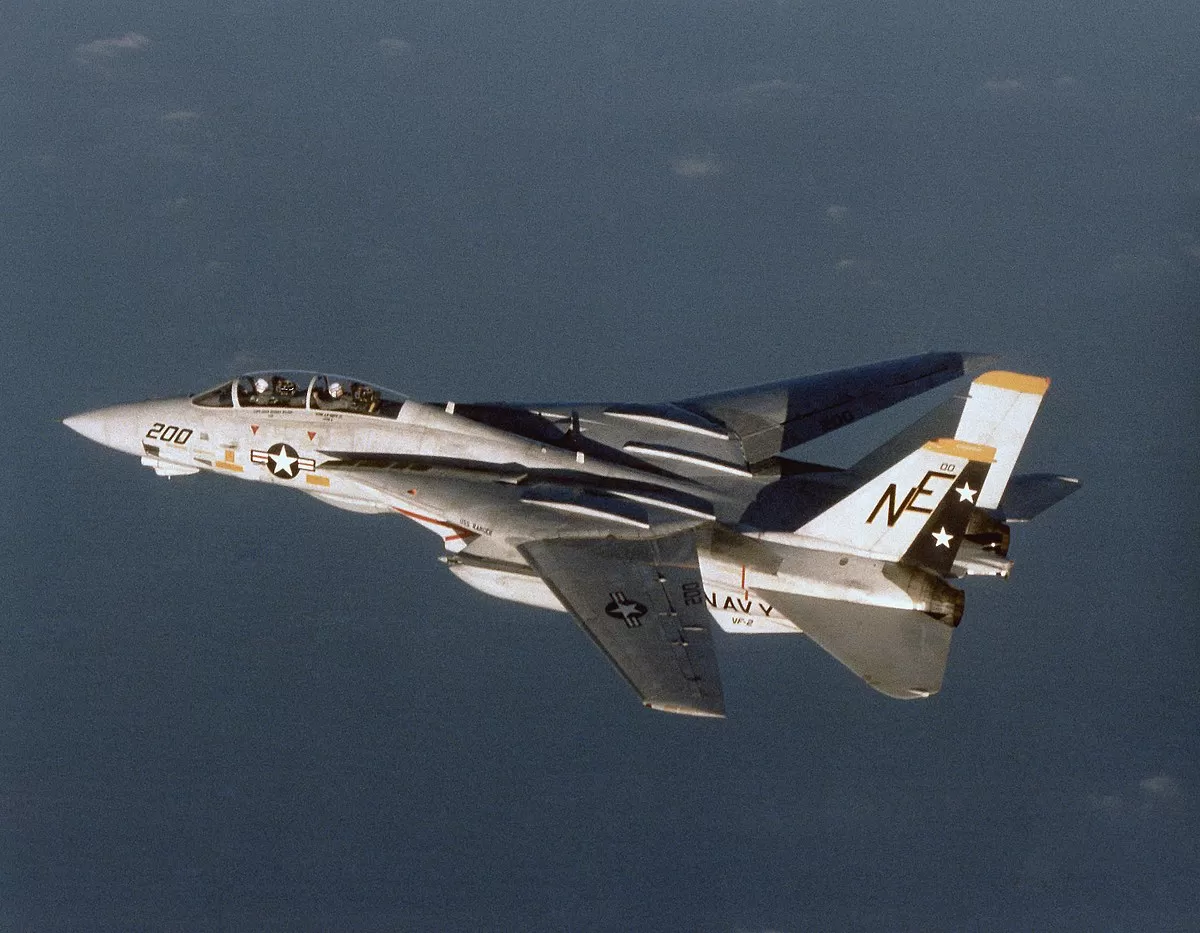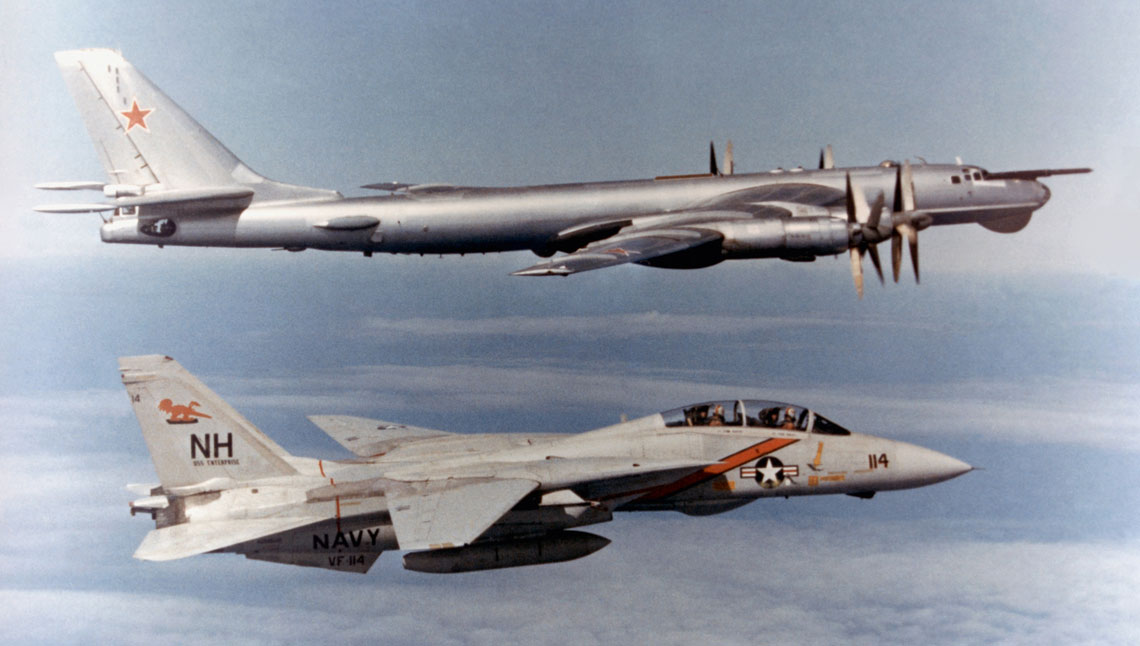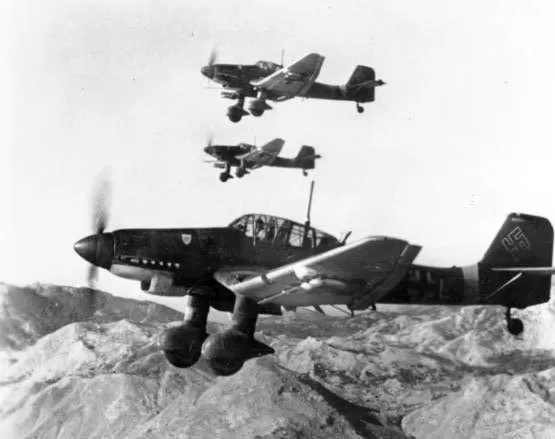
Grumman F-14 Bombcat Part 1

Initially, the main task of the F-14 Tomcat was the air defense of American aircraft carriers and their escorts.
ships and gaining air superiority in the airborne operations area.
The history of the airborne homing fighter Grumman F-14 Tomcat can be divided into two periods. For the first decade or so, the F-14A served as a "fleet defender" - an interceptor whose most important task was to combat Soviet long-range bombers - carriers of winged anti-ship missiles and other aircraft that could threaten the group's American aircraft carrier. The F-14A proved its worth by shooting down two Libyan Su-22 fighter-bombers and two MiG-23 fighters in two engagements in 1981 and 1989 over Sirte Sirte.
In the 80s, the "romantic" image of the F-14A Tomcat was immortalized in two feature films - The Last Countdown from the 1980s and most of all in Top Gun, Tony Scott's acclaimed 1986 film. -14A services also involve working with unreliable and too weak propulsion systems, which have caused many disasters. Only the entry into service of the upgraded F-14B and F-14D models with new engines solved these problems.
In the early 90s, when the F-14 Tomcat finally became a fully mature design, the Pentagon made the decision to end its production. The plane seemed doomed. Then began the second stage in the history of the fighter. Through several modifications and the introduction of a LANTIRN-type navigation and guidance system, the F-14 Tomcat has evolved from a "single mission" platform into a truly multi-role fighter-bomber. Over the next decade, F-14 Tomcat crews carried out precision attacks against ground targets with laser-guided bombs and GPS signals, carried out close support missions for their own troops, and even fired at ground targets with deck guns. If in the late 70s the Navy pilots had heard in what role the F-14 ended their service, no one would have believed it.
In the late 50s, the US Navy (US Navy) developed the concept of building a long-range airborne fighter - the so-called. fleet defenders. It was supposed to be a heavy fighter armed with air-to-air missiles, capable of intercepting Soviet bombers and destroying them at safe distances - far from their own aircraft carriers and ships.
In July 1960, Douglas Aircraft received a contract to build the F-6D Missileer heavy fighter. It was to have a crew of three and carry AAM-N-3 Eagle long-range missiles with conventional or nuclear warheads. It soon became clear that the heavy fighter would need its own hunting cover, and the whole concept was unlikely to work. A few years later, the idea of a heavy fighter was revived when Secretary of Defense Robert McNamara tried to push through the construction of an airborne version of the General Dynamics F-10A bomber under the TFX (Tactical Fighter Experimental) program. The airborne version, designated F-111B, was to be built jointly by General Dynamics and Grumman. However, the F-111B proved too large and difficult to operate from aircraft carriers. After the F-111A, he "inherited" a two-seat cockpit with side-by-side seats and variable geometry wings with a span of 111 m (folded) to 10,3 m (unfolded).
Seven prototypes were built, the first of which was tested in May 1965. Three of them crashed, resulting in the death of four crew members. The Navy was against the adoption of the F-111B, and this decision was supported by congressmen. The project was eventually canceled and in July 1968 the Navy solicited proposals for the newly launched Heavy Airborne VFX (Experimental Naval Fighter) program. Five companies participated in the tender: Grumman, McDonnel Douglas, North American Rockwell, General Dynamics and Ling-Temco-Vought. Grumman decided to use his experience in the F-111B program, including the variable geometry wing concept. Seven different aerodynamic configurations were carefully studied, most of them without variable geometry wings. Eventually, in late 1968, Grumman submitted the 303E, a two-seat, twin-engine variable-wing fighter, to tender.
However, unlike the F-111B, it uses a twin vertical tail, pilot and radar intercept officer (RIO) seats arranged in tandem, and engines located in two separate nacelles. As a result, under the fuselage there was a place for four beams of suspension arms. In addition, the weapons were supposed to be carried on two beams placed under the so-called. gloves, that is, wing fairings in which the "movable" wings "worked". Unlike the F-111B, it was not planned to mount beams under the moving parts of the wings. The fighter was to be equipped with systems developed for the F-111B, including: Hughes AN / AWG-9 radar, AIM-54A Phoenix long-range air-to-air missiles (designed by Hughes specifically for radar operation) and Pratt & Whitney TF30-P-12. On January 14, 1969, the 303E project became the winner in the VFX program, and the Navy officially designated the new fighter as the F-14A Tomcat.

The main armament of the F-14 Tomcat fighters for combating air targets were six long-range AIM-54 Phoenix air-to-air missiles.
F-14A - engine problems and structural maturation
In 1969, the US Navy awarded Grumman a preliminary contract to build 12 prototypes and 26 production units. Ultimately, 20 FSD (Full Scale Development) test samples were allocated for the testing phase. The first F-14A (BuNo 157980) left the Grumman plant at Calverton, Long Island in late 1970. His flight on 21 December 1970 went smoothly. However, the second flight, made on December 30, ended in disaster due to the failure of both hydraulic systems during the landing approach. The crew managed to eject, but the plane was lost.
The second FSD (BuNo 157981) flew on 21 May 1971. FSD No. 10 (BuNo 157989) was delivered to the NATC Naval Test Center at Patuxent River for structural and deck testing. On June 30, 1972, it crashed while preparing for an air show on the Patuxent River. Test pilot William "Bill" Miller, who survived the crash of the first example, died in the crash.
In June 1972, FSD No. 13 (BuNo 158613) took part in the first onboard tests - on the aircraft carrier USS Forrestal. Prototype No. 6 (BuNo 157984) was intended for weapons testing at the Point Mugu base in California. On 20 June 1972, F-14A No. 6 shot itself down when a fired AIM-7E-2 Sparrow medium-range air-to-air missile hit the fighter on separation. The crew managed to eject. The first launch of the AIM-54A long-range missile from an F-14A took place on 28 April 1972. The Navy was very pleased with the performance of the AN/AWG-9-AIM-54A system. The range of the radar, operating in the X-band and at frequencies of 8-12 GHz, was within 200 km. It could simultaneously track up to 24 targets, visualize 18 on the TID (tactical information display) located at the RIO station, and aim weapons at six of them.
The radar had the function of simultaneously scanning and tracking detected targets and could detect targets flying in front of the ground (surface). Within 38 seconds, the F-14A could fire a salvo of six AIM-54A missiles, each of which is capable of destroying targets flying at different heights and in different directions. Missiles with a maximum range of 185 km developed a speed of Ma = 5. Tests have shown that they can also destroy low-altitude cruise missiles and rapidly maneuvering targets. On January 28, 1975, the AIM-54A Phoenix missiles were officially adopted by the US Navy.
Unfortunately, the situation with the drive was somewhat different.
Pratt & Whitney TF14-P-30 engines were chosen to drive the F-412A, with a maximum thrust of 48,04 kN each and 92,97 kN in afterburner. It was a modified version of the TF30-P-3 engines used in the F-111A fighter-bomber. They were supposed to be less emergency than the -P-3 engines, and the greater spacing of the engine nacelles was to prevent problems arising during the operation of the F-111A. In addition, the assembly of the R-412 engines was supposed to be a temporary solution. The US Navy assumed that only the first 67 F-14As would be equipped with them. The next version of the fighter - F-14B - was supposed to receive new engines - Pratt & Whitney F401-PW-400. They were developed jointly with the US Air Force as part of the ATE (Advanced Turbofan Engine) program. However, this did not happen and the Navy was forced to continue purchasing F-14As with TF30-P-412 engines. In general, they were too heavy and too weak for the F-14A. They also had design flaws, which soon began to appear.
In June 1972, the first F-14A was delivered to the US-based Miramar VF-124 "Gunfighters" Naval Training Squadron. The first line squadron to receive the new fighters was the VF-1 Wolf Pack. Almost simultaneously, the conversion to the F-14A was carried out by the squadron VF-2 "Headhunters". In October 1972, both units declared their F-14 Tomcat operational readiness. In early 1974, VF-1 and VF-2 took part in their first combat flight aboard the aircraft carrier USS Enterprise. At that time, Grumman had already delivered about 100 examples to the fleet, and the total flight time of the F-14 Tomcat was 30. watch.
In April 1974, the first F-14A crash was due to an engine failure. By October 1975, there had been five engine failures and fires resulting in the loss of four fighters. The situation was so serious that the Navy ordered extensive engine checks (including disassembly) to be carried out every 100 flight hours. The entire fleet stopped three times. A total of 1971 F-1976As were lost between 18 and 14 as a result of accidents caused by engine failure, fire, or malfunction. Two major problems were found with the TF30 engines. The first was the separation of the fan blades, which were made of insufficiently strong titanium alloys.
There was also not enough protection in the engine bay to keep the fan blades from moving out when disconnected. This resulted in significant damage to the engine structure, which almost always resulted in a fire. The second problem turned out to be "chronic" for TF30 engines and was never completely eliminated. It consisted in the sudden occurrence of uneven operation of the compressor (pump), which could lead to a complete failure of the engine. Pumping could occur at almost any height and speed. Most often, it appeared when flying at low speed at high altitudes, when turning on or off the afterburner, and even when launching air-to-air missiles.
Sometimes the engine immediately returned to normal on its own, but usually the pumping was delayed, which led to a rapid drop in engine speed and an increase in temperature at the compressor inlet. Then the aircraft began to roll along the longitudinal axis and yaw, which usually ended in an uncontrolled spin. If it was a flat spin, the crew, as a rule, had only to eject. The spin could have been avoided if the pilot had reacted early enough by reducing the engine speed to a minimum and stabilizing the flight so that no g-forces occurred. Then, with a slight descent, one could try to restart the compressor. Pilots quickly learned that the F-14A needed to be flown quite "carefully" and be prepared for pumping during sudden maneuvers. According to many, it was more like "managing" the operation of engines than controlling a fighter.
In response to the problems, Pratt & Whitney modified the engine with stronger fans. Modified engines, designated TF30-P-412A, began to be assembled in copies of the 65th serial block. As part of another modification, the chamber around the first three stages of the compressor was sufficiently reinforced, which was supposed to stop the blades after a possible separation. Modified engines, designated TF30-P-414, began to be assembled in January 1977 as part of the 95th production batch. By 1979, all F-14As delivered to the Navy were equipped with modified P-414 engines.
In 1981, Pratt & Whitney developed a variant of the engine, designated TF30-P-414A, which was supposed to eliminate the bleeding problem. Their assembly began in the budget year 1983 in the 130th production block. By the end of 1986, the new engines were installed in the F-14A Tomcat already in service, during technical inspections. In fact -P-414A showed a much lower propensity to pump. On average, one case was recorded per thousand flight hours. However, this tendency could not be completely eliminated, and when flying with high angles of attack, a compressor stall could occur.
